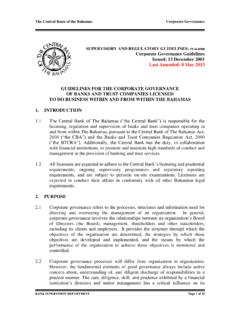Transcription of Sonali Sharma and Anahita Irani - Global Securitisation
1 Global Securitisation and structured Finance 2008 105 Juris Corp16 Acquisition financing in IndiaSonali Sharma and Anahita IraniJuris CorpAlthough the Indian deals market has been abuzz with large acquisitions,both national and cross-border, what is notable is the growing trendamong Indian corporates of acquiring companies far larger than themselvesin offshore jurisdictions. The acquisition of Corus, a company with a capacityof million tonnes a year, by Tata Steel, whose capacity at the time ofacquisition was a mere million tonnes a year, for $ billion in January2007 is a case in point. Also notable is the acquisition of Novellis by HindalcoIndustries for $6 billion in May 2007. While Indian corporates areaggressively expanding their horizons, their counterparts offshore aresimilarly targeting and acquiring or setting up operations within s long-drawn-out acquisition of a 67 per cent stake in HutchisonEssar at $ billion was one of the largest foreign investment transactionin India to date.
2 While availability of funds is a favourable driver forinvestments, mergers and acquisitions, it has been the structuring optionsdevised for Indian acquirers which have enabled them to make acquisitionsoffshore as, unlike their offshore counterparts, Indian corporates are facedwith hurdles in the form of domestic legal and regulatory restrictions whenembarking on any acquisition generally arise depending on the nature of the company beingacquired, as well as whether the acquisition and the funding are on a cross-border basis or on a purely onshore basis. In addition, there are restrictionsdepending on the type of financier, as well as the options available to securethe financier s interests, whether by way of collateral or debt regulations impose restrictions on the ability of banks in India inrelation to acquisition financing, prohibiting them from lending to aborrower, irrespective of whether the borrower is located offshore oronshore, or whether the funds are to be used to purchase shares of an IndianGlobal Securitisation and structured Finance 2008I Acquisition financing in India106 Global Securitisation and structured Finance 2008 Juris Corpcompany.
3 However, there is an exemption as regardsloans for acquisition of shares of an onshoreinfrastructure company upon the fulfilment of certainconditions. In addition, funding by Indian banks toIndian corporates, up to stipulated limits, is permittedfor the acquisition of offshore degree of exposure to capital markets of a bankin India is also subject to stringent limits. While offshorebanks (which, for the purposes of exposure limits, includeforeign branches of Indian banks) are not subject to mostof these restrictions; under Indian exchange control laws,foreign currency loans, including the proceeds of foreigncurrency convertible bonds and external commercialborrowings (ECBs) cannot be availed of for the purposesof onshore acquisitions. Although ECBs could be utilisedfor the acquisition of offshore companies, the variousrestrictions, including the all-in-cost ceilings and the capon interest, make it difficult for many Indian companiesto resort to them to these restrictions, financing offshoreacquisitions by an Indian company are structured suchthat the borrower is an offshore subsidiary and/or aspecial purpose vehicle set up by the Indian structures can be used by an Indian companyfor onshore acquisitions as well; however, in such casescertain issues relating to round-tripping servicing is an additional issue to be dealt withwhile structuring an acquisition.
4 One option is thepayment of dividends by the Indian target , this is not a tax-efficient way to upstreamcash to the borrower to enable it to service the fundsraised, as under Indian law a dividend distribution tax ofapproximately 17 per cent is payable by the Indiantarget company. In the event that the transactions arestructured as a two-tier holding structure for thepurposes of acquiring the Indian target company, thetax is payable twice. In addition, this does not guaranteea steady stream of funds, as while the payment ofdividends is correlated to the profits made by the Indiantarget company, it is also entirely at the discretion ofboard of directors of the Indian target company. Theutilisation of any offshore earnings of the borrower orthe Indian target company could also be of shares by the Indian target company is astructuring possibility. However, under Indian law acompany faces limitations on the percentage of itsshares it can buy back.
5 The current limits are 10 per centof its shares with board approval and 25 per cent of itsshares with prior shareholder approval. There areadditional qualitative restrictions, including that onlyone buy-back is permissible within any 12-monthperiod. Furthermore, each buy-back is subject to asolvency test, including certification of solvency fromthe target s auditors and a declaration of solvency bythe board of directors of the target. In addition,depending on the jurisdiction of the borrower, the taxincidence would have to be evaluated to ascertainwhether there would be any exemption from the Indianwithholding tax on the capital gains arising from a sharebuy-back. The borrower s choice of jurisdiction isgenerally driven by taking into consideration theincidence and rate of withholding tax on interest andtax on capital the exposure of Indian banks to the capitalmarkets is subject to prescribed ceilings, Indiancompanies and sponsors resort to borrowing from non-banking financial companies (NBFCs).
6 As thenomenclature indicates, these are quasi-banks thatcannot take on-demand deposits or issue cheque banks, NBFCs have no limit on capital marketexposure. Therefore, they can take security in the formof pledge of shares of Indian companies without havingto worry about hitting capital market exposure , if the NBFC has an asset size of Rs1 billion(approximately $25 million), it is classified as asystematically important NBFC and must maintain acapital adequacy ratio of 10 per cent. In addition,systematically important NBFCs have counterpartyexposure norms (15 per cent for a single borrower and25 per cent for borrowers belonging to the same group).Given the capital adequacy and single and groupborrower restrictions, most systematically importantNBFCs do not have the balance-sheet size to undertakebig-ticket financing in India IGlobal Securitisation and structured Finance 2008 Global Securitisation and structured Finance 2008107 Juris CorpDue to the nature of activity conducted by hedgefunds, they are categorised and must be registered asNBFCs in India.
7 Hedge funds are yet to begin theirentire range of activities in India (and those that haveset up shop in India are primarily facilitating offshoreinvestments into India), due to the restrictionsstipulated under the NBFC regulations, pursuant towhich, as registered NBFCs, they must maintainprescribed capital adequacy ratios (which wouldeffectively restrict the quantum of leverage) and aresubject to counterparty lending exposure has resulted in most sectors ofoperations of Indian companies being made open toforeign direct investment, thereby making it easier forIndian companies to raise finance through offshoreinvestments, the only limitation being that theproceeds of the foreign investments raised cannot beutilised to acquire shares of existing Indian , Indian subsidiaries of foreign companies are notpermitted to raise funds onshore from any source forthe purposes of making acquisitions in invariably seek to secure their interests byinsisting on collateral.
8 For an Indian borrower to grantsecurity over certain types of asset, including thoselocated in India in favour of an offshore lender, priorReserve Bank of India (RBI) approval is , if the loan is granted by an offshore lender(which is a regulated bank) to a borrower locatedoutside India, prior RBI approval is not required if theIndian parent pledges the shares in the borrower infavour of such lender. While this exception exists, it is amoot point whether the same could be used in the caseof a consortium lending where the consortium includesnon-bank entities in the lender group and/or if thefunds are raised by the issuance of most cases, guarantees are also obtained fromthe borrower and/or the onshore corporate promotersor associates of such promoters. No RBI approval isrequired for the giving of such guarantee if certainconditions are fulfilled. These include the financialcommitment (whether in the form of equity,shareholder loan or guarantee) of the onshore companyto its offshore subsidiaries or joint ventures notexceeding 400 per cent of its net worth, as indicated inits latest audited financial in the case of listed companies mustalso comply with various other regulations, includingthose under the Securities and Exchange Board of India(Substantial Acquisition of Shares & Takeovers)Regulations 1997 (known as the Takeover Code) and theSecurities and Exchange Board of India (Buy-Back ofSecurities) Regulations 1998.
9 Under the Takeover Code,acquisitions of or in excess of 15 per cent of shares, oracquisitions of control in any manner, require priorpublic announcements and open offers to be made bythe acquirers. However, it is possible to acquire stakes ina listed company without making a publicannouncement by resorting to the provisions of theCompanies Act 1956, under which schemes of merger,demerger, amalgamation and arrangement can beeffectuated pursuant to the prior approval of the Competition Act 2002, as amended by theCompetition (Amendment) Act 2007, will, on being fullynotified, throw a spanner in the booming mergers andacquisitions arena in India, as well as for those mergersand acquisitions taking place outside India which have adirect or indirect connection to competition withinIndia. The thresholds prescribed for mandatorynotification to the Competition Commission of India arerelatively low for certain sectors, particularly whencompared with offshore jurisdictions, and purelyoffshore acquisitions are also targeted.
10 The thresholdsprescribed for mandatory notification relate to thecombined assets of the acquirer and the target in India,or the combined assets of the parties in or outside notified, the commission has 210 days to conductinquiries and issue an order regarding whether, in itsopinion, the proposed acquisition or merger is likely tocause an appreciable adverse impact on competitionwithin India. If, any person is aggrieved by the orderpassed by the commission, an appeal can be filed within60 days before the Competition Appellate Authority;thereafter, a further appeal can be filed within a periodof 60 days before the Supreme Court of India. The onlyGlobal Securitisation and structured Finance 2008I Acquisition financing in India108 Global Securitisation and structured Finance 2008 Juris Corpacquisitions exempted from the examination by thecommission and which need only be intimated to thecommission are those resulting pursuant to anycovenant of a loan agreement or investment agreemententered into by public financial institutions, foreigninstitutional investors, banks and venture capital , there is no guidance on how conflicts betweenthe Competition Act and other laws and regulations,including the Takeover Code, should be any type of regulatory approval is animpediment to an acquisition transaction and - giventhe uncertain timeframes involved and the possibility ofrefusal of approval.





